- Accueil
- Pages cachées
- 15 DECEMBRE 2023 NEWS
15 DECEMBRE 2023 NEWS
INSTITUT SUPERIEUR D'ANTHROPOLOGIE
INSTITUT OF ANTHROPOLOGY
COURS ONLINE – COURS A DISTANCE
INSCRIPTIONS OUVERTES
REGISTER NOW
TURQUIE – 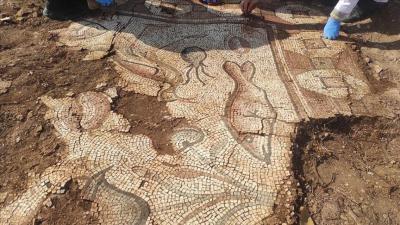
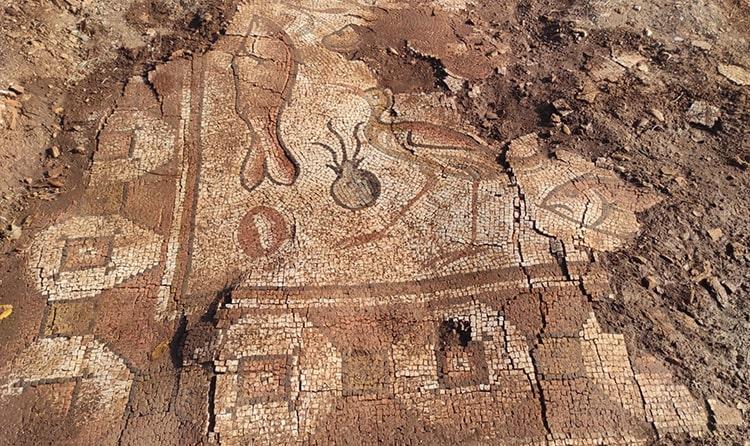 Kela Hanma - Archaeologists discovered mosaics believed to be from the Roman era during a rescue excavation undertaken in a rural expanse in the Kızıltepe district of Mardin in southeastern Türkiye. In the countryside of Uzunkaya Neighbourhood, which is about 30 kilometers away from the district center, officials investigated the area known as Kela Hanma (Lady’s Castle) upon a report of illegal excavation. During the investigations, it was determined that the architectural texture of the area was destroyed and there were many illegal excavation pits in the area. Following reports of illicit excavations and the destruction of the architectural fabric in the area, researchers delved into the site to uncover ancient treasures hidden beneath the ground. A rescue excavation was started on 2 October in the said area under the chairmanship of Mardin Museum Director Abdulgani Tarkan, with the participation of expert archaeologist and art historian Volkan Bağlayıcı, Museum Specialist Archaeologist Mehmet Şan and 6 workers, and teams from Diyarbakır Restoration and Conservation Regional Laboratory Directorate. The excavation revealed mosaic floor tiles belonging to a Villa Rustica, a rural settlement enclosed by walls, comprising a central structure along with smaller auxiliary buildings distributed around it. The mosaic floor, measuring approximately 100 square meters, exhibited intricate designs depicting fish scales, triangles, hexagons, octagons, arch formations, trees, waterfowl, octopuses, fish, mussels, seals, and aquatic plant imagery. “These mosaics, adorned with animal figures and rare sea creatures like octopuses and various fish species, are distinctive in this region. Our priority is to preserve these historical relics to prevent further deterioration,” Tarkan emphasized.
Kela Hanma - Archaeologists discovered mosaics believed to be from the Roman era during a rescue excavation undertaken in a rural expanse in the Kızıltepe district of Mardin in southeastern Türkiye. In the countryside of Uzunkaya Neighbourhood, which is about 30 kilometers away from the district center, officials investigated the area known as Kela Hanma (Lady’s Castle) upon a report of illegal excavation. During the investigations, it was determined that the architectural texture of the area was destroyed and there were many illegal excavation pits in the area. Following reports of illicit excavations and the destruction of the architectural fabric in the area, researchers delved into the site to uncover ancient treasures hidden beneath the ground. A rescue excavation was started on 2 October in the said area under the chairmanship of Mardin Museum Director Abdulgani Tarkan, with the participation of expert archaeologist and art historian Volkan Bağlayıcı, Museum Specialist Archaeologist Mehmet Şan and 6 workers, and teams from Diyarbakır Restoration and Conservation Regional Laboratory Directorate. The excavation revealed mosaic floor tiles belonging to a Villa Rustica, a rural settlement enclosed by walls, comprising a central structure along with smaller auxiliary buildings distributed around it. The mosaic floor, measuring approximately 100 square meters, exhibited intricate designs depicting fish scales, triangles, hexagons, octagons, arch formations, trees, waterfowl, octopuses, fish, mussels, seals, and aquatic plant imagery. “These mosaics, adorned with animal figures and rare sea creatures like octopuses and various fish species, are distinctive in this region. Our priority is to preserve these historical relics to prevent further deterioration,” Tarkan emphasized.
Roman Mosaic found during rescue excavation in southeast Türkiye - Arkeonews
Rép. TCHEQUE – 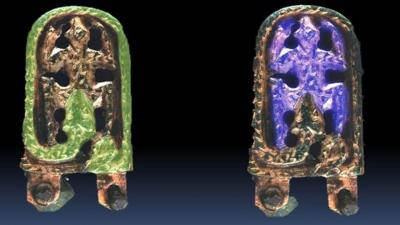 Břeclav - Archaeologists have unearthed a bronze belt buckle from the early Middle Ages, depicting a snake devouring a frog-like creature. Researchers believe that the finding may shed more light on the spiritual life of people in the pre-Christian period, about which little is known. The discovery was made by archaeologists from Masaryk University in Brno, near the town of Břeclav in Southern Moravia, and dates to the eighth century. Such ornaments were worn by elites in East Central Europe in the early Middle Ages It was a part of a costume worn by the Avars, the nomadic people settled in the Carpathian basin, in today’s Hungary. However, it was also worn by neighbouring nations or groups of people. It was a very interesting discovery for us because we came across this Avar belt while excavating a settlement of early Slavs” The belt depicts a snake devouring a frog-like creature. This motif which is common for Germanic, Avar as well as Slavic mythology and which is most likely associated with the myth of the world’s creation or the fertility cult. Also, this scene in nature can signify the end of a cycle and the beginning of something new. Hundreds of kilometers apart, nearly similar belt buckles have already been found in other parts of Central Europe. However, experts believe that this motif played a very crucial role in the religious and spiritual life of the people who lived in this part of the world in the early Middle Ages.“The problem is that we know very little about the pre-Christian religion among the Germanic people and the Slavic people. We have nearly no written sources about it. We believe that this scene of the fighting snake could be connected with the pre-Christian religion of the people of central Europe. Therefore, such archaeological discoveries could be very important to the discussion about the religion of these people before Christianity.” said Mr. Macháček.
Břeclav - Archaeologists have unearthed a bronze belt buckle from the early Middle Ages, depicting a snake devouring a frog-like creature. Researchers believe that the finding may shed more light on the spiritual life of people in the pre-Christian period, about which little is known. The discovery was made by archaeologists from Masaryk University in Brno, near the town of Břeclav in Southern Moravia, and dates to the eighth century. Such ornaments were worn by elites in East Central Europe in the early Middle Ages It was a part of a costume worn by the Avars, the nomadic people settled in the Carpathian basin, in today’s Hungary. However, it was also worn by neighbouring nations or groups of people. It was a very interesting discovery for us because we came across this Avar belt while excavating a settlement of early Slavs” The belt depicts a snake devouring a frog-like creature. This motif which is common for Germanic, Avar as well as Slavic mythology and which is most likely associated with the myth of the world’s creation or the fertility cult. Also, this scene in nature can signify the end of a cycle and the beginning of something new. Hundreds of kilometers apart, nearly similar belt buckles have already been found in other parts of Central Europe. However, experts believe that this motif played a very crucial role in the religious and spiritual life of the people who lived in this part of the world in the early Middle Ages.“The problem is that we know very little about the pre-Christian religion among the Germanic people and the Slavic people. We have nearly no written sources about it. We believe that this scene of the fighting snake could be connected with the pre-Christian religion of the people of central Europe. Therefore, such archaeological discoveries could be very important to the discussion about the religion of these people before Christianity.” said Mr. Macháček.
EGYPTE – 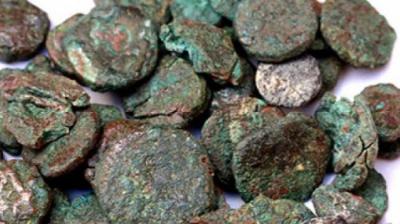 Marca - Numismatists from the Faculty of Archaeology at the University of Warsaw have examined thousands of previously ignored small coins (Nummi Minimi) discovered in the ancient city of Marea, located 45 kilometers southwest of Alexandria. Their findings are reshaping the literature’s established understanding of monetary circulation in Egypt at the end of antiquity. Marea, known as Filoksenite during the Byzantine period was a large port town located to the south-west of Alexandria. In Ancient times it was famous, among other things, for its excellent wine which was sold in all parts of the Mediterranean. Located on Lake Mariut near Alexandria, it was an important port in the Roman and Byzantine times, and probably existed already in the Ptolemaic times. As it was linked by canals to the Nile and the Mediterranean Sea, also products from Upper Egypt were brought there. The importance of Marea is evidenced by the four long piers, the longest of which (125 m) was built from strong stone ashlars bound with waterproof mortar. It developed remarkable infrastructure and architecture during the reign of Emperor Justinian, and it became an important place of rest for pilgrims en route to the tomb of Saint Menas, one of the most famous martyrs in Christian history, which is situated in the Egyptian desert. The Polish Centre of Mediterranean Archaeology UW (University of Warsaw) has been conducting archaeological research in Marea since 2000. The current work is supervised by Professor Tomasz Derda. Currently, excavations are underway in the extensive bath complex. Excavations also continue in the large basilica built during Justinian’s reign. According to the University of Warsaw press release, these important findings were possible primarily due to focusing on the most numerous (approximately 75 percent of the total number of finds), although seemingly least attractive group of coins: those with a diameter of only a few millimeters, called nummi minimi. The majority of “nummi minimi” were stored in bags, numerous remnants of which were discovered at the site. These coins have been largely marginalized in scientific publications until now. However, numismatists from the University of Warsaw decided to examine each specimen, even the smallest and poorly preserved ones. Thanks to this, they discovered that in the group of “nummi minimi” found in Marea (Filoksenite), coins minted in Carthage by the Vandal kings predominated and, subsequently, after the recovery of Africa from the barbarians, by Justinian.The researchers also identified Ostrogothic small coins, which – like Vandal coins – began to flow widely into the eastern Mediterranean after the Ostrogothic kingdom was ended by Justinian. Among the coins found in Marea, a significant percentage are local Egyptian imitations. They include coins inspired by the coinage of the Kingdom of Aksum and imitations of Byzantine coins minted in Alexandria. A surprisingly large number of them are called “blanki,” that is, empty coin discs made of copper or lead that functioned as spare coins.
Marca - Numismatists from the Faculty of Archaeology at the University of Warsaw have examined thousands of previously ignored small coins (Nummi Minimi) discovered in the ancient city of Marea, located 45 kilometers southwest of Alexandria. Their findings are reshaping the literature’s established understanding of monetary circulation in Egypt at the end of antiquity. Marea, known as Filoksenite during the Byzantine period was a large port town located to the south-west of Alexandria. In Ancient times it was famous, among other things, for its excellent wine which was sold in all parts of the Mediterranean. Located on Lake Mariut near Alexandria, it was an important port in the Roman and Byzantine times, and probably existed already in the Ptolemaic times. As it was linked by canals to the Nile and the Mediterranean Sea, also products from Upper Egypt were brought there. The importance of Marea is evidenced by the four long piers, the longest of which (125 m) was built from strong stone ashlars bound with waterproof mortar. It developed remarkable infrastructure and architecture during the reign of Emperor Justinian, and it became an important place of rest for pilgrims en route to the tomb of Saint Menas, one of the most famous martyrs in Christian history, which is situated in the Egyptian desert. The Polish Centre of Mediterranean Archaeology UW (University of Warsaw) has been conducting archaeological research in Marea since 2000. The current work is supervised by Professor Tomasz Derda. Currently, excavations are underway in the extensive bath complex. Excavations also continue in the large basilica built during Justinian’s reign. According to the University of Warsaw press release, these important findings were possible primarily due to focusing on the most numerous (approximately 75 percent of the total number of finds), although seemingly least attractive group of coins: those with a diameter of only a few millimeters, called nummi minimi. The majority of “nummi minimi” were stored in bags, numerous remnants of which were discovered at the site. These coins have been largely marginalized in scientific publications until now. However, numismatists from the University of Warsaw decided to examine each specimen, even the smallest and poorly preserved ones. Thanks to this, they discovered that in the group of “nummi minimi” found in Marea (Filoksenite), coins minted in Carthage by the Vandal kings predominated and, subsequently, after the recovery of Africa from the barbarians, by Justinian.The researchers also identified Ostrogothic small coins, which – like Vandal coins – began to flow widely into the eastern Mediterranean after the Ostrogothic kingdom was ended by Justinian. Among the coins found in Marea, a significant percentage are local Egyptian imitations. They include coins inspired by the coinage of the Kingdom of Aksum and imitations of Byzantine coins minted in Alexandria. A surprisingly large number of them are called “blanki,” that is, empty coin discs made of copper or lead that functioned as spare coins.
Thousands of ignored ‘Nummi Minimi’ Coins Found in the Ancient City of Marea in Egypt - Arkeonews
CANADA – Mount Edziza, - Northern Canada is known for its blustery weather, dramatic landscape, and plentiful ice. But with an unprecedented thaw in Canada’s Mount Edziza Provincial Park the past few years, objects began emerging from the ice. Some of the manmade possessions are 7,000 years old, and they belonged to the Tahltan First Nations. Mount Edziza, a volcano located in northwestern British Columbia, has remained a significant hunting ground for the Tahltan nation for thousands of years. With this discovery, archaeologists are now able to gain more insight into what life was like for people here since around 5,000 B.C. There were containers crafted from birch bark, antler ice picks, tools carved from bones, walking sticks, and even a stitched boot. Among the artifacts discovered were also tools fashioned from obsidian, the black glass created by lava flows. Many others are made from materials such as leather, wood, and bone. Within nine patches of ice, 56 objects were recovered overall. “Archeologists were able to carbon-date the organic materials, such as the digging sticks and leather items,” says Karn. “Carbon dating provides researchers with an idea of when the tools were made and how they were used.” Of particular interest to researchers are two bark containers that are believed to be around 2,000 years old. One has detailed stitching along one edge that is still largely intact. The second container is more unique. Sticks are stitched to the inside of the container to reinforce the framework, creating a basket that could bear heavier loads. The team also found an ice pick, carved from an antler, or ede’ in Tahltan, that was dated at around 5,000 years old—a useful tool for Indigenous residents of a cold, snowy region. Though one end appears to be broken, researchers were able to see the antler had been intentionally sharpened and shaped with a handle for ease of use.The remains of a shoe, which McLaren describes as a moccasin-like boot, consists of complicated stitching and flaps—further evidence that early Tahltan hunters created complex items to thrive in the harsh climate of the region. Of note, says McLaren, is that the design hasn’t changed much through the millenia. “It is very similar to the types people have been wearing historically through the years,” he notes.
Ancient Objects Found in Ice in Canada - Atlas Obscura
ITALIE – 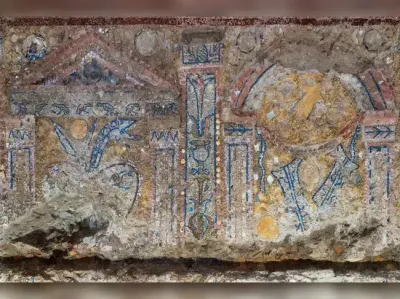 Rome - Archaeologists have uncovered a luxurious Roman home near the Colosseum, boasting an "unparalleled" mosaic featuring shells, marble and precious glass, the culture ministry said Tuesday. Three large ships ride waves in the mosaic towards a coastal city, its walls dotted with small towers and porticoes in a scene suggesting the owner of the more than 2,000-year-old home, or domus, had been victorious in battle. The building, which dates to between the second half of the 2nd century BC and the end of the 1st century BC, is "an authentic treasure", Culture Minister Gennaro Sangiuliano said in a statement. Brought to light after archaeologists discovered a series of walls in 2018, the domus is spread over several floors. So far only some rooms have been excavated, and the dig will continue well into 2024. Set around an atrium, the domus's main room is a banquet hall styled as a grotto, which was used during the summer months, the ministry said. The owner, a nobleman likely to have been a senator, would have entertained guests with "spectacular water games", thanks to lead pipes set between the decorated walls, it said. But what "makes the discovery exceptional is... an extraordinary wall covered with a so-called 'rustic' mosaic unparalleled in terms of the chronology and the complexity of the scenes depicted," it added. A "complex sequence" of scenes are depicted through "different types of shells, Egyptian blue tesserae, precious glass, minute flakes of white marble or other types of stone", according to the ministry. Among the vines and lotus leaves lie piles of weapons with Celtic-type trumpets, warships, and tridents, "alluding perhaps to a double triumph, terrestrial and naval, of the owner of the domus".There is "a fascinating depiction" of a landscape, complete with coastal city and a cliff, simulated with travertine rock, facing "the sea ploughed by three large ships, one of which has raised sails". "The representation of a coastal city could allude to a warlike conquest by the owner of the domus, belonging to an aristocratic personage, presumably of senatorial rank," the ministry said. Archaeologists also uncovered a white stucco "of the highest quality" in the adjoining reception room. "We will work intensively to make this place, one of the most evocative in ancient Rome, accessible to the public as soon as possible," said Alfonsina Russo, head of the Colosseum Archaeological Park. The domus is an early example of "luxuria", the displaying of wealth and rank through sumptuous villas and lifestyles. It is also supports historical sources which describe th ..
Rome - Archaeologists have uncovered a luxurious Roman home near the Colosseum, boasting an "unparalleled" mosaic featuring shells, marble and precious glass, the culture ministry said Tuesday. Three large ships ride waves in the mosaic towards a coastal city, its walls dotted with small towers and porticoes in a scene suggesting the owner of the more than 2,000-year-old home, or domus, had been victorious in battle. The building, which dates to between the second half of the 2nd century BC and the end of the 1st century BC, is "an authentic treasure", Culture Minister Gennaro Sangiuliano said in a statement. Brought to light after archaeologists discovered a series of walls in 2018, the domus is spread over several floors. So far only some rooms have been excavated, and the dig will continue well into 2024. Set around an atrium, the domus's main room is a banquet hall styled as a grotto, which was used during the summer months, the ministry said. The owner, a nobleman likely to have been a senator, would have entertained guests with "spectacular water games", thanks to lead pipes set between the decorated walls, it said. But what "makes the discovery exceptional is... an extraordinary wall covered with a so-called 'rustic' mosaic unparalleled in terms of the chronology and the complexity of the scenes depicted," it added. A "complex sequence" of scenes are depicted through "different types of shells, Egyptian blue tesserae, precious glass, minute flakes of white marble or other types of stone", according to the ministry. Among the vines and lotus leaves lie piles of weapons with Celtic-type trumpets, warships, and tridents, "alluding perhaps to a double triumph, terrestrial and naval, of the owner of the domus".There is "a fascinating depiction" of a landscape, complete with coastal city and a cliff, simulated with travertine rock, facing "the sea ploughed by three large ships, one of which has raised sails". "The representation of a coastal city could allude to a warlike conquest by the owner of the domus, belonging to an aristocratic personage, presumably of senatorial rank," the ministry said. Archaeologists also uncovered a white stucco "of the highest quality" in the adjoining reception room. "We will work intensively to make this place, one of the most evocative in ancient Rome, accessible to the public as soon as possible," said Alfonsina Russo, head of the Colosseum Archaeological Park. The domus is an early example of "luxuria", the displaying of wealth and rank through sumptuous villas and lifestyles. It is also supports historical sources which describe th ..
CHINE - Ningbo, - Rich archaeological findings spanning over 4,000 years from the Neolithic Hemudu culture to the Song Dynasty (960-1279) have been unearthed in a site in Ningbo, east China's Zhejiang Province, according to the Ningbo municipal research academy of cultural heritage management. The Chenwang site, which was first discovered in June 2022 in Ningbo's Fenghua District, is divided into two sections with respective areas of 3,400 square meters and 4,400 square meters. According to Ding Fengya, the person in charge of the excavation site, the excavation took place from February to August this year, revealing six historic layers, the earliest representing the late stage of the Hemudu culture. Most of the unearthed relics date back to the prehistoric period, and include earthen platforms, tombs, wooden cellar pits, and ash trenches from the fourth phase of Hemudu culture, as well as house remains, pottery fragments and stone tools from the Liangzhu culture. Patterned pottery fragments from the Warring States period (475-221 BC), house foundations and construction parts from the Han (202 BC-220 AD) and Six (222-589) dynasties, and porcelain from the Tang (618-907) and Song dynasties are among the other discoveries. The archaeological materials unearthed at this site have significant value in constructing the regional cultural development context and studying changes in human settlements, according to the Ningbo municipal research academy of cultural heritage management. The Hemudu culture originated from the Hemudu site, which was discovered 50 years ago in today's Yuyao City, under the administration of Ningbo. The site has a history dating back about 5,300 to 7,000 years, and its discovery is regarded as a significant milestone in the archaeology of the Neolithic era in southern China.
Relics spanning over 4,000 years unearthed in Zhejiang - China.org.cn
IRAQ – 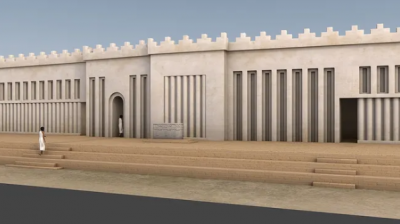 Girsu - Two temples, one built on top of the other, have been unearthed at the site of the Sumerian city of Girsu, which is located in southeastern Iraq, according to a Live Science report. The more recent temple, dated to the fourth century B.C. and dedicated to Hercules and his Sumerian equivalent, Ningirsu or Ninurta, contained a brick bearing an inscription in Aramaic and Greek referencing the rare Babylonian ceremonial name Adadnadinakhe, “the giver of two brothers.” A Greek drachm found beneath an altar bears images of a lightning bolt and an eagle, both symbols of Zeus, the Greek sky god. The Greek coin, minted during the rule of Alexander the Great, also features an image of Hercules that strongly resembles conventional representations of Alexander on one side, with Zeus on the other, explained Sebastien Rey of the British Museum. Zeus was said to have claimed Alexander as his son through the Ammon oracle, making Alexander and Heracles brothers, and thus Zeus became “the giver of two brothers,” Rey explained. The Sumerian temple situated directly beneath the Hellenistic temple had been constructed 1,500 years earlier. “It shows that the inhabitants of Babylonia in the [fourth] century B.C. had a vast knowledge of their history,
Girsu - Two temples, one built on top of the other, have been unearthed at the site of the Sumerian city of Girsu, which is located in southeastern Iraq, according to a Live Science report. The more recent temple, dated to the fourth century B.C. and dedicated to Hercules and his Sumerian equivalent, Ningirsu or Ninurta, contained a brick bearing an inscription in Aramaic and Greek referencing the rare Babylonian ceremonial name Adadnadinakhe, “the giver of two brothers.” A Greek drachm found beneath an altar bears images of a lightning bolt and an eagle, both symbols of Zeus, the Greek sky god. The Greek coin, minted during the rule of Alexander the Great, also features an image of Hercules that strongly resembles conventional representations of Alexander on one side, with Zeus on the other, explained Sebastien Rey of the British Museum. Zeus was said to have claimed Alexander as his son through the Ammon oracle, making Alexander and Heracles brothers, and thus Zeus became “the giver of two brothers,” Rey explained. The Sumerian temple situated directly beneath the Hellenistic temple had been constructed 1,500 years earlier. “It shows that the inhabitants of Babylonia in the [fourth] century B.C. had a vast knowledge of their history,
Ancient Temples Explored at Sumerian City of Girsu - Archaeology Magazine
SUEDE – 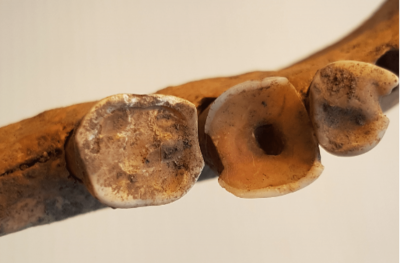 Varnhem - Viking Age teeth at Varnhem indicate surprisingly advanced dentistry, according to the results of a study conducted at the University of Gothenburg. In 2005, excavations in Varnhem, Sweden uncovered the remains of a Christian church, near which was a cemetery containing thousands of Viking graves dating to the 10th to 12th century AD. The site is known for extensive excavations of Viking and medieval environments, including tombs where skeletons and teeth have been preserved well in favorable soil conditions. In this study, Carolina Bertilsson and colleagues performed clinical and radiographical examinations of the dentition of individuals from this site. In total, the team analyzed more than 3,293 teeth from 171 individuals individuals. The teeth underwent clinical examinations using standard dentistry tools under bright light. A number of X-ray examinations were also performed using the same technique used in dentistry, where the patient bites down on a small square imaging plate in the mouth. The results, which have been published in the journal PLOS ONE, show that 49% of the Viking population had one or more caries lesions. Of the adults’ teeth, 13% were affected by caries – often at the roots. However, children with milk teeth – or with both milk and adult teeth – were entirely caries-free. Tooth loss was also common among adults. The studied adults had lost an average of 6% of their teeth, excluding wisdom teeth, over their lifetimes. The risk of tooth loss increased with age. The findings suggest that caries, tooth infections, and toothache were common among the Viking population in Varnhem. However, the study also reveals examples of attempts to look after teeth in various ways. “There were several signs that the Vikings had modified their teeth, including evidence of using toothpicks, filing front teeth, and even dental treatment of teeth with infections,” says Carolina Bertilsson, a dentist and Associate Researcher, and the study’s first-named and corresponding author. One sign of more sophisticated procedures was molars with filed holes, from the crown of the tooth and into the pulp, probably in order to relieve pressure and alleviate severe toothache due to infection. “This is very exciting to see, and not unlike the dental treatments we carry out today when we drill into infected teeth. The Vikings seem to have had knowledge about teeth, but we don’t know whether they did these procedures themselves or had help.”
Varnhem - Viking Age teeth at Varnhem indicate surprisingly advanced dentistry, according to the results of a study conducted at the University of Gothenburg. In 2005, excavations in Varnhem, Sweden uncovered the remains of a Christian church, near which was a cemetery containing thousands of Viking graves dating to the 10th to 12th century AD. The site is known for extensive excavations of Viking and medieval environments, including tombs where skeletons and teeth have been preserved well in favorable soil conditions. In this study, Carolina Bertilsson and colleagues performed clinical and radiographical examinations of the dentition of individuals from this site. In total, the team analyzed more than 3,293 teeth from 171 individuals individuals. The teeth underwent clinical examinations using standard dentistry tools under bright light. A number of X-ray examinations were also performed using the same technique used in dentistry, where the patient bites down on a small square imaging plate in the mouth. The results, which have been published in the journal PLOS ONE, show that 49% of the Viking population had one or more caries lesions. Of the adults’ teeth, 13% were affected by caries – often at the roots. However, children with milk teeth – or with both milk and adult teeth – were entirely caries-free. Tooth loss was also common among adults. The studied adults had lost an average of 6% of their teeth, excluding wisdom teeth, over their lifetimes. The risk of tooth loss increased with age. The findings suggest that caries, tooth infections, and toothache were common among the Viking population in Varnhem. However, the study also reveals examples of attempts to look after teeth in various ways. “There were several signs that the Vikings had modified their teeth, including evidence of using toothpicks, filing front teeth, and even dental treatment of teeth with infections,” says Carolina Bertilsson, a dentist and Associate Researcher, and the study’s first-named and corresponding author. One sign of more sophisticated procedures was molars with filed holes, from the crown of the tooth and into the pulp, probably in order to relieve pressure and alleviate severe toothache due to infection. “This is very exciting to see, and not unlike the dental treatments we carry out today when we drill into infected teeth. The Vikings seem to have had knowledge about teeth, but we don’t know whether they did these procedures themselves or had help.”
Viking Dentistry Was Surprisingly Advanced And Not Unlike Today’s Treatments - Arkeonews